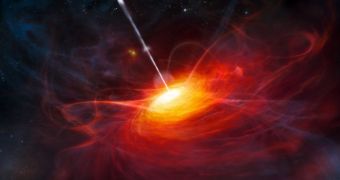A group of astronomers announce the discovery of an extremely bright active galaxy in the distant Universe. The structure, which is believed to be a quasar, may very well be the most luminous object of its class to exist such a short time after the Big Bang.
According to the study team, the object may shed more light on the evolution of supermassive black holes, the dark behemoths that are today powering the cores of all large galaxies. The Milky Way has such a black hole itself.
ULAS J1120+0641, the distant object the team found, is in fact a quasar, or a quasi-stellar radio source. This class of objects is made up of very energetic and distant active galactic nuclei, which emit vast amounts of electromagnetic radiation in a large portion of the spectrum.
The main source of fuel for these black holes is their accretion disks. These are structures that accumulate material from the object's surroundings, which they then slowly channel through the event horizon. As this happens, the material is being heated up to millions of degrees Celsius.
The friction and heat trigger the release of massive amounts of radiation. Due to the long distance separating Earth from these objects, the light is shifted to redder, longer wavelengths, Space reports.
Early estimates on ULAS J1120+0641's brightness indicate that it gives off 60 trillion times more light than our Sun. The European Southern Observatory (ESO) Very Large Telescope (VLT) and the Gemini North Telescope were used to assess the distance to the quasar.
The data indicate that the galactic core existed in the form we see today, just 770 million years after the Big Bang exploded the Universe into being, and only a few hundred million years after the appearance of the first stars.
“The search was very long and slow – kind of like panning for gold and seeing lots of shiny things glinting in the pan, only for most of them to be old nails, until finally one candidate turned out to be what we were looking for,” Daniel Mortlock explains.
The investigators holds an appointment as an astrophysicist at the Imperial College London (ICL). He says that the new study indicates the black hole is about 2 billion times more massive than the Sun.
This discovery poses a serious problem for astronomical theories, since none of the latter can explain why such a tremendously-massive object existed so early in the history of the Cosmos.
“While it's not the most massive quasar black hole known, it is seen so much earlier than the others that it is even harder to form in the time available,” Mortlock writes in the June 30 issue of the top scientific journal Nature.

 14 DAY TRIAL //
14 DAY TRIAL //